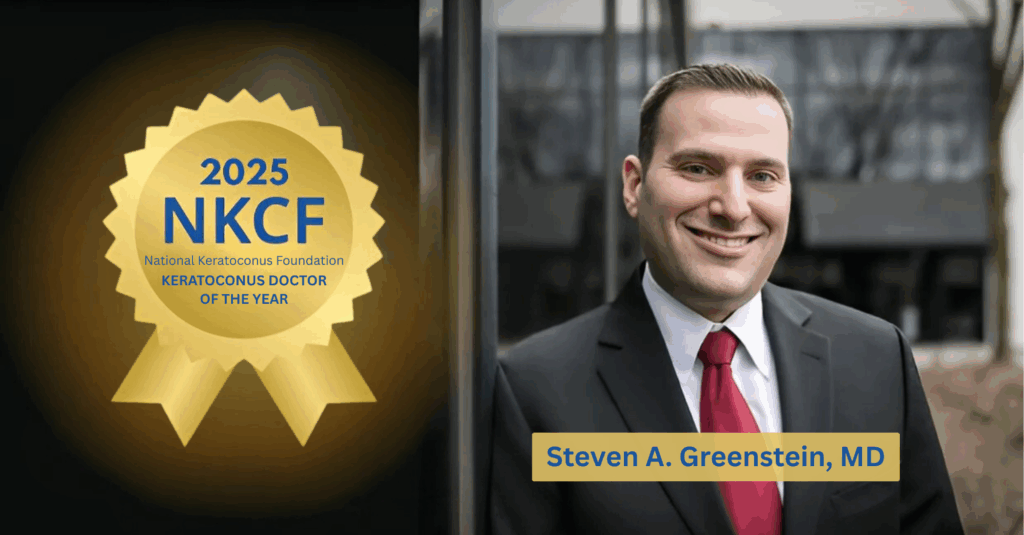Each year, the National Keratoconus Foundation (NKCF) recognizes two clinicians—one ophthalmologist and one optometrist—who have made exceptional contributions to the keratoconus (KC) community. We’re proud to share that the 2025 Ophthalmology recipient of the NKCF Keratoconus Doctor of the Year Award is our very own Dr. Steven Greenstein.
Dr. Greenstein is a leading cornea and refractive surgeon and serves as the Medical Director and Director of Refractive Surgery right here at the Cornea and Laser Eye Institute (CLEI) and its Center for Keratoconus in New Jersey. As co-inventor of the groundbreaking Corneal Tissue Addition Keratoplasty (CTAK) procedure, developed alongside Dr. John Gelles and Dr. Peter Hersh, he has helped reshape the future of keratoconus surgery.
NKCF honors Dr. Greenstein for his decades of dedication to crosslinking research, corneal reshaping, and patient education.
A Lifelong Commitment to the Keratoconus Community
In a special interview, Dr. Greenstein reflected on how far the field has come, the unique needs of KC patients, and what’s next for keratoconus management. Below are some of the highlights.
During his interview, Dr. Greenstein explained that his journey in keratoconus care began during medical school, when he joined the CLEI Center for Keratoconus at the dawn of corneal collagen crosslinking research. That early exposure to a groundbreaking treatment—and the mentorship of Dr. Peter S. Hersh—inspired a lifelong commitment to innovation and patient-centered care. “Being “on the cutting edge” of the first major innovation for keratoconus in decades ignited my lifelong passion for this work,” he shared.
As he delved into the field, Dr. Greenstein began to recognize just how fragmented keratoconus care had become. Patients were often shuffled between clinics for routine eye exams, specialty contact lenses, and surgical procedures—with little coordination between providers. Happily, realizing how hard it was for patients to understand the full range of keratoconus treatment options led to the creation of a fully integrated model of care. “Today, together with Dr. John Gelles, I’m honored to lead the CLEI Center for Keratoconus—the first dedicated subspecialty center for keratoconus in the nation—where we offer all of these services under one roof. Coordinating cross-linking, corneal reshaping, and vision correction in one setting allows us to personalize care and expose patients to the full range of options, rather than just one,” he explains.
Throughout the interview, Dr. Greenstein emphasized the emotional toll of keratoconus and the importance of education and reassurance. Many of his patients are young and newly diagnosed, facing their first chronic condition. “The first thing I do is listen,” he says. Dr. Greenstein aims to understand each patient’s vision goals. “Understanding those goals allows me to match treatment options to the individual. Most people diagnosed with keratoconus are young; for many it’s their first chronic disease. That’s why I spend extra time reassuring them that the condition is manageable and that multiple treatment stages may be required,” he says.
He also highlighted one powerful moment that continues to reinforce his comprehensive approach. It involved a keratoconus patient who Dr. Greenstein had previously treated with topography-guided PRK followed by cataract surgery. The surgeries resulted in unaided vision good enough for the patient to be able to see without wearing contact lenses. When a house fire broke out, the patient was able to escape safely because he could see without wearing his scleral lenses. “He told me that being able to see without them saved his life,” Dr. Greenstein recalls. “That moment reminded me why improving unaided, functional vision matters just as much as surgical precision.” The story brought into focus the psychological burden many individuals with keratoconus carry: the fear of being suddenly helpless if a contact lens is lost or damaged. It reinforced the importance of offering vision-improving procedures that go beyond basic stabilization, allowing patients to live with less anxiety about the “what if” moments in life.
Looking ahead, Dr. Greenstein is focused on advancing early detection efforts, advocating for pediatric screening, and continuing to refine corneal reshaping techniques. His hope? That every person with keratoconus is treated with comprehensive, compassionate care—and a strong community to walk with them through it.
From pioneering new treatments to emphasizing communication and education, Dr. Greenstein’s patient-centered approach to keratoconus continues to change lives. His career reflects a long-standing commitment to innovation and compassionate care—and we couldn’t be prouder.





